- Cart 0
- English
Unlocking the Secrets of Animal Brain Organoids: A Comprehensive Culturing Guide
Procedure

Organoid Primary Culture Procedure
Primary Culture
I. Preparation
1. Equipment
CO2 incubator, double-person single-sided laminar flow cabinet, inverted microscope, benchtop refrigerated centrifuge, water bath or water bath shaker, medical refrigerator, -80℃ freezer, pipette set, ophthalmic scissors, ophthalmic forceps
2. Reagents and Consumables (taking colorectal cancer as an example)
Animal Brain Organoid Culture Medium Kit (abs90050), Matrigel (low factor, phenol red-free) (abs9495), 60mm tissue culture dish, 100μm cell strainer, 15mL centrifuge tube, several 1.5mL EP tubes, 24-well cell culture plate, metal ice box, ophthalmic scissors, ophthalmic forceps
|
Component Name |
Specification |
|
Animal Brain Organoid Culture Medium A |
100mL |
|
Organoid Primary Culture Buffer B |
250mL |
|
Primary Tissue Digestion Solution C |
30mL |
|
Organoid Passaging Digestion Solution D |
30mL |
|
Tissue Preservation Solution E |
100mL |
|
Organoid Cryopreservation Solution F |
20mL |
|
Organoid Passaging Culture Buffer G |
250mL |
II. Operating Procedure
1. Sample Preparation
(1) Place the tissue into a sampling bottle containing pre-cooled (2-8°C) Tissue Preservation Solution E (submerge the entire tissue), and transport it from the hospital/laboratory at 4℃;
(2) Sterilize the sampling bottle, remove the tissue and place it into a culture dish for sample photography, and register information such as size, color, hardness, and tissue type.

2. Washing and Mincing
(1) Immerse in 2-3mL Primary Culture Buffer B in a 60mm tissue culture dish. Wash the tissue three times with Primary Culture Buffer B (changing the culture dish each time) and mince it into approximately 1-3mm3 tissue blocks, then transfer to a 15mL centrifuge tube.
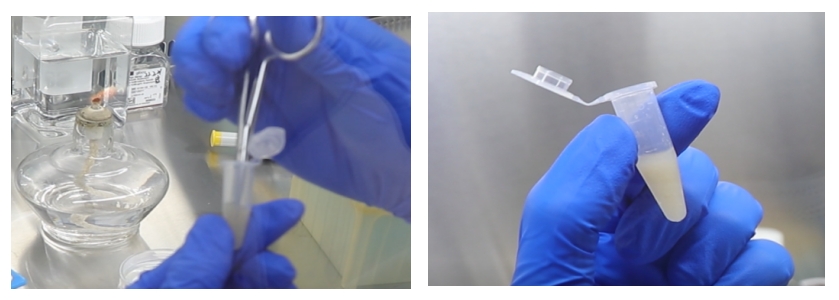
3. Digestion and Filtration
(1) Add 5 times the volume of Primary Tissue Digestion Solution C to the 15mL centrifuge tube (digestion solution volume: tissue volume = 5:1, if estimating tissue volume is difficult, 5mL digestion solution is usually sufficient) and digest at 37℃ for 15-30min (monitor the digestion process).
(2) Take a small amount of liquid and observe under a microscope. When many cell clusters (5-50 cells per cluster) are observed, add 3 times the volume of Primary Culture Buffer B (buffer volume: digestion solution volume = 3:1) to terminate digestion. Gently pipette the mixture to see it become turbid.
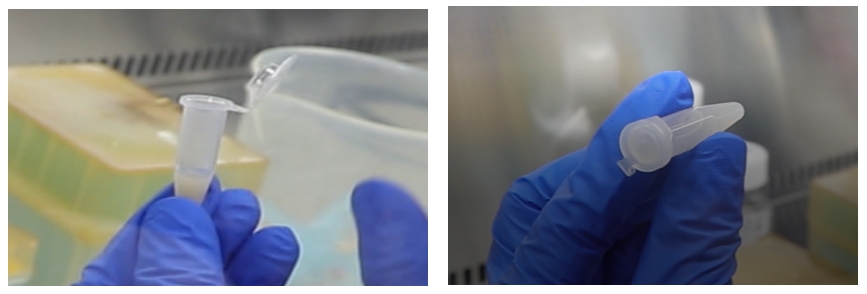
(3) Filter using a 100μm cell strainer and observe a small amount of filtrate under the microscope. Collect the filtrate into a 15mL centrifuge tube, centrifuge at 300g at 4℃ for 5min, and remove the supernatant.

4. Gel Addition - Seeding - Media Addition (This is the key step in the primary operation)
(1) Preparation
a. The Matrigel should be thawed overnight in a metal ice box at 4℃;
b. Pipette tips and centrifuge tubes should be pre-chilled at -20℃ for at least half an hour;
c. The thawed Matrigel can be stored at 4℃, and it is recommended to use it within 2 weeks.
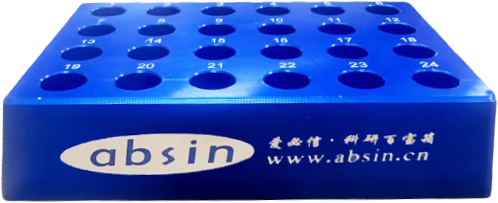
Low-Temperature Metal Ice Box (abs7289)
(2) Seeding Requirements
24-well plate, 25uL Matrigel-cell cluster mixture per well, 500-750uL organoid culture medium.
(3) Seeding Density
Density suggestion 1: Matrigel volume: cell cluster sediment volume = 25:1 (if estimating the cell cluster sediment volume is difficult, 300uL Matrigel is usually sufficient)
Density suggestion 2: 500 cell clusters/25uL Matrigel (if counting and seeding is desired, refer to this density suggestion)
(4) Gel Addition - Seeding
Add Matrigel (abs9495) to the cell cluster sediment, gently mix by pipetting (avoid excessive pipetting to prevent bubble formation), and then seed the mixture. The entire operation should be conducted on a metal ice box or ice. Once proficient, the gel addition, mixing, and seeding should be completed within half a minute to maintain the fluidity of the Matrigel.
(5) Media Addition
Place the seeded culture plate in a 37℃ incubator for 40-60min to allow gel formation, then add 500-750μL Organoid Culture Medium A for culture. After approximately 10-14 days, when most organoids reach a diameter of 200um-500um, they can be passaged.
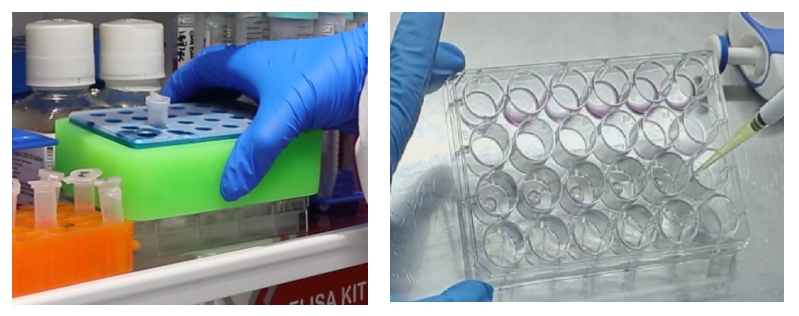
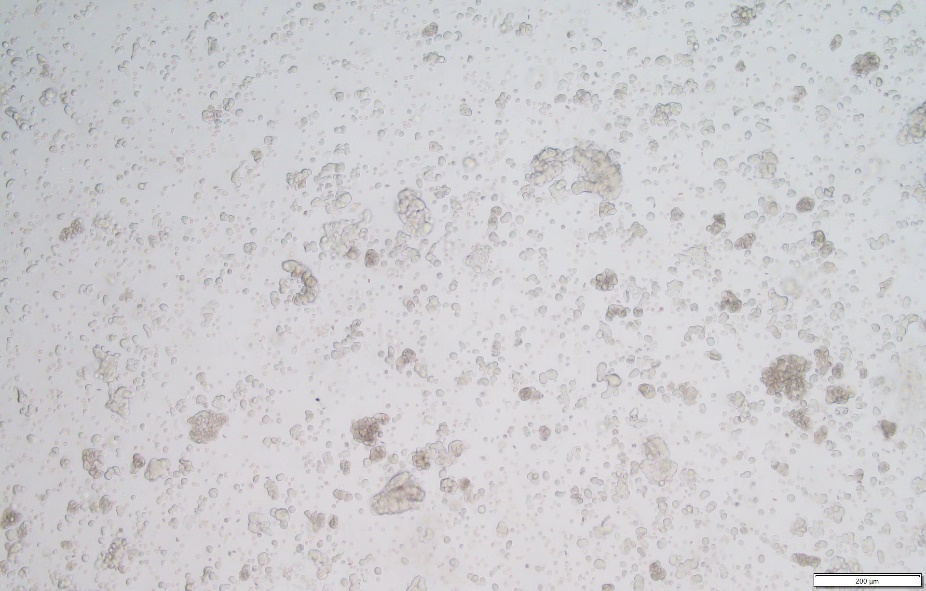
Seeding Density
Passaging (Digestion varies in two cases)
I. Passaging Steps for a Large Number of Organoids or Larger Organoids
1. Collection and Washing of Organoids
(1) Collection: Aspirate the culture medium with a pipette, add 1-2mL of Organoid Passaging Culture Buffer G at 4℃ to each well, gently disperse the Matrigel, and collect into a 15mL centrifuge tube (for a 24-well plate, collect every 5 wells as a group).
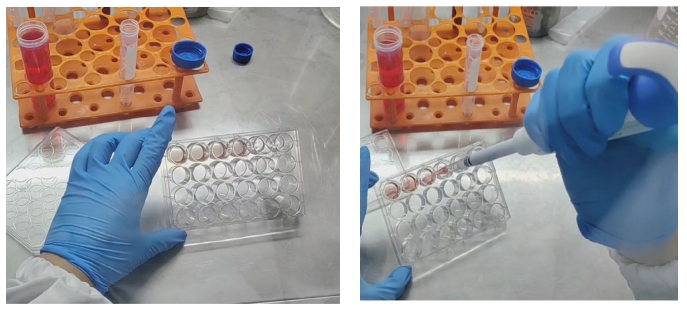
(2) Washing: Dilute with Organoid Passaging Culture Buffer G to a total volume of 14mL (the more buffer used, the more the Matrigel is diluted and easier to remove), and let it stand at 4℃ for 40min or place it at -20℃ for 5min (to soften the Matrigel; if the refrigerator has strong insulation, shorten the freezing time. When exploring the appropriate freezing time, shake the centrifuge tube and if no Matrigel is visible, it indicates that the Matrigel has been sufficiently softened).
(3) Next, centrifuge the centrifuge tube at 300g, 4℃, for 5min. After centrifugation, there are usually two situations:
The first situation is normal, with three layers separated (as shown in the figure below). In this case, discard the supernatant and Matrigel layer, and retain the organoid sediment.

The second situation is abnormal, with only two layers separated (as shown in the figure below). This situation may be related to insufficient cooling. In this case, discard the buffer and retain the Matrigel-organoid suspension. Repeat the previous washing step and cool again. Usually, clear separation into three layers (buffer layer, Matrigel layer, organoid sediment layer) will occur. At this point, discard the supernatant and Matrigel layer, and retain the organoid sediment. If it still shows two layers (buffer layer and Matrigel-organoid suspension layer), discard the buffer and the top 1/3 of the Matrigel-organoid suspension, and retain the bottom 2/3.

Conditions to promote effective separation of Matrigel and organoids:
a. The choice of centrifuge is very important. A horizontal angle centrifuge is more favorable for separating Matrigel and organoids compared to a fixed angle centrifuge;
b. The temperature of the centrifuge should ideally be 4℃ (to prevent Matrigel from solidifying). The centrifugation speed can be slightly increased (not exceeding 500g), and the centrifugation time can be extended (not exceeding 10min).
2. Organoid Digestion
(1) Add 2-3mL of Organoid Passaging Digestion Solution D to digest in the laminar flow cabinet for 2-3min, with pipetting 1-2 times during digestion. This step should primarily digest the organoids into cell clusters, not single cells, as single-cell organoids have a low survival rate. If uncertain whether the digestion is appropriate, take a few microliters and observe under the microscope. If many cell clusters are visible, stop digestion.
(2) Add 5 times the volume of Organoid Passaging Culture Buffer G (buffer volume: digestion solution volume = 5:1) to terminate digestion. Centrifuge at 300g at 4℃ for 5min and discard the supernatant (if there is residual Matrigel, a residual volume < 50uL is normal and does not affect the proliferation of passaged organoids).

3. Gel Addition - Seeding - Media Addition
(1) Preparation
(a) Thaw the Matrigel overnight in a metal ice box at 4℃;
(b) Pre-chill pipette tips and centrifuge tubes at -20℃ for at least half an hour;
(c) The thawed Matrigel can be stored at 4℃, and it is recommended to use it within 2 weeks.
(2) Seeding Requirements
24-well plate, 25uL Matrigel-cell cluster mixture per well, 500-750uL organoid culture medium.
(3) Seeding Density
Density suggestion 1: Organoids are typically passaged at a 1:2 ratio, for example, if collecting from 5 wells of a 24-well plate, seed into 10 wells. The required Matrigel volume is 25*10=250uL.
Density suggestion 2: 500 cell clusters/25uL Matrigel (if counting and seeding is desired, refer to this density suggestion)
Note: Whether following Density Suggestion 1 or Density Suggestion 2, if there is residual Matrigel, the new Matrigel volume should be at least 1.5 times the residual Matrigel volume.
(4) Gel Addition - Seeding
Add Matrigel (abs9495) to the cell cluster sediment, gently mix by pipetting (avoid excessive pipetting to prevent bubble formation), and then seed the mixture. The entire operation should be conducted on a metal ice box or ice. Once proficient, the gel addition, mixing, and seeding should be completed within half a minute to maintain the fluidity of the Matrigel.
(5) Media Addition
Place the seeded culture plate in a 37℃ incubator for 40-60min to allow gel formation, then add 500-750μL Organoid Culture Medium A for culture. After approximately 10-14 days, when most organoids reach a diameter of 200-300um, they can be passaged.
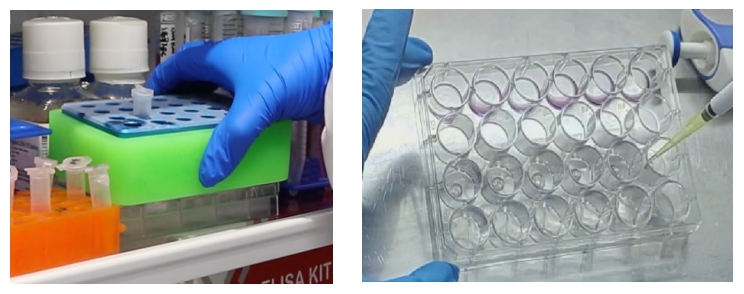
II. When the Number of Organoids is Insufficient or the Size is Small:
1. Collection, Blowing, and Washing of Organoids
(1) Aspirate the culture medium with a pipette, add 1-2mL of Organoid Passaging Culture Buffer G at 4℃ to each well, and gently disperse the Matrigel;
(2) Blow to create cell clusters (stop blowing when many cell clusters are visible under the microscope);
(3) Washing: For a 24-well plate, collect every 5 wells as a group into a 15mL centrifuge tube, dilute with Organoid Passaging Culture Buffer G to a total volume of 14mL (the more buffer used, the more the Matrigel is diluted and easier to remove), and let it stand at 4℃ for 40min or place it at -20℃ for 5min (to soften the Matrigel; if the refrigerator has strong insulation, shorten the freezing time. When exploring the appropriate freezing time, shake the centrifuge tube and if no Matrigel is visible, it indicates that the Matrigel has been sufficiently softened);
(4) Next, centrifuge the centrifuge tube at 300g, 4℃, for 5min. After centrifugation, there are usually two situations:
The first situation is normal, with three layers separated (as shown in the figure below). In this case, discard the supernatant and Matrigel layer, and retain the cell cluster sediment.

The second scenario is abnormal, resulting in only two layers (as shown in the figure below). This situation may be related to insufficient cooling. In this case, discard the buffer and retain the Matrigel-organoid suspension. Repeat the previous washing step and re-perform the cooling centrifugation. Typically, clear separation into three layers (buffer layer, Matrigel layer, and organoid sediment layer) will occur. At this point, discard the supernatant and the Matrigel layer, and retain the organoid sediment. If it still shows two layers (buffer layer and Matrigel-cell cluster suspension layer), discard the buffer and the top 1/3 of the Matrigel-cell cluster suspension, and retain the bottom 2/3.

Conditions to promote effective separation of Matrigel and organoids:
a. The choice of centrifuge is very important. A horizontal angle centrifuge is more favorable for separating Matrigel and organoids compared to a fixed-angle centrifuge;
b. The temperature of the centrifuge should ideally be 4℃ (to prevent Matrigel from solidifying), the centrifugation speed can be slightly increased (not exceeding 500g), and the centrifugation time can be extended (not exceeding 10min).
2. Organoid Digestion
(1) Add 2-3mL of Organoid Passaging Digestion Solution D to digest in the laminar flow cabinet for 2-3min, with pipetting 1-2 times during digestion. This step should primarily digest the organoids into cell clusters, not single cells, as single-cell organoids have a low survival rate. If uncertain whether the digestion is appropriate, take a few microliters and observe under the microscope. If many cell clusters are visible, stop digestion.
(2) Add 5 times the volume of Organoid Passaging Culture Buffer G (buffer volume: digestion solution volume = 5:1) to terminate digestion, centrifuge at 300g at 4℃ for 5min, and discard the supernatant (if there is residual Matrigel, a residual volume < 50uL is normal and does not affect the proliferation of passaged organoids).

3. Gel Addition - Seeding - Media Addition
(1) Preparation
a. Thaw the Matrigel overnight in a metal ice box at 4℃;
b. Pre-chill pipette tips and centrifuge tubes at -20℃ for at least half an hour;
c. The thawed Matrigel can be stored at 4℃, and it is recommended to use it within 2 weeks.
(2) Seeding Requirements
24-well plate, 25uL Matrigel-cell cluster mixture per well, 500-750uL organoid culture medium.
(3) Seeding Density
Density suggestion 1: Organoids are typically passaged at a 1:2 ratio, for example, if collecting from 5 wells of a 24-well plate, seed into 10 wells. The required Matrigel volume is 25*10=250uL.
Density suggestion 2: 500 cell clusters/25uL Matrigel (if counting and seeding is desired, refer to this density suggestion)
Note: Whether following Density Suggestion 1 or Density Suggestion 2, if there is residual Matrigel, the new Matrigel volume should be at least 1.5 times the residual Matrigel volume.
(4) Gel Addition - Seeding
Add Matrigel (abs9495) to the cell cluster sediment, gently mix by pipetting (avoid excessive pipetting to prevent bubble formation), and then seed the mixture. The entire operation should be conducted on a metal ice box or ice. Once proficient, the gel addition, mixing, and seeding should be completed within half a minute to maintain the fluidity of the Matrigel.
(5) Media Addition
Place the seeded culture plate in a 37℃ incubator for 40-60min to allow gel formation, then add 500-750μL Organoid Culture Medium A for culture. After approximately 10-14 days, when most organoids reach a diameter of 200-300um, they can be passaged.

II. When the Number of Organoids is Insufficient or the Size is Small:
1. Collection, Blowing, and Washing of Organoids
(1) Aspirate the culture medium with a pipette, add 1-2mL of Organoid Passaging Culture Buffer G at 4℃ to each well, and gently disperse the Matrigel;
(2) Blow to create cell clusters (stop blowing when many cell clusters are visible under the microscope);
(3) Washing: For a 24-well plate, collect every 5 wells as a group into a 15mL centrifuge tube, dilute with Organoid Passaging Culture Buffer G to a total volume of 14mL (the more buffer used, the more the Matrigel is diluted and easier to remove), and let it stand at 4℃ for 40min or place it at -20℃ for 5min (to soften the Matrigel; if the refrigerator has strong insulation, shorten the freezing time. When exploring the appropriate freezing time, shake the centrifuge tube and if no Matrigel is visible, it indicates that the Matrigel has been sufficiently softened);
(4) Next, centrifuge the centrifuge tube at 300g, 4℃, for 5min. After centrifugation, there are usually two situations:
The first situation is normal, with three layers separated (as shown in the figure below). In this case, discard the supernatant and Matrigel layer, and retain the cell cluster sediment.

The second situation is abnormal, with only two layers separated (as shown in the figure below). This situation may be related to insufficient cooling. In this case, discard the buffer and retain the Matrigel-organoid suspension. Repeat the previous washing step and re-perform the cooling centrifugation, usually clear separation into three layers (buffer layer, Matrigel layer, organoid sediment layer) will occur. At this point, discard the supernatant and Matrigel layer, and retain the organoid sediment. If it still shows two layers (buffer layer and Matrigel-cell cluster suspension layer), discard the buffer and the top 1/3 of the Matrigel-cell cluster suspension, and retain the bottom 2/3.

Conditions to promote effective separation of Matrigel and organoids:
a. The choice of centrifuge is very important. A horizontal angle centrifuge is more favorable for separating Matrigel and organoids compared to a fixed-angle centrifuge;
b. The temperature of the centrifuge should ideally be 4℃ (to prevent Matrigel from solidifying), the centrifugation speed can be slightly increased (not exceeding 500g), and the centrifugation time can be extended (not exceeding 10min).
II. Cryopreservation of Organoids
1. Cryopreservation Density, taking a 24-well plate as an example
Density Suggestion 1:2 wells/mL cryopreservation solution
Density Suggestion 2:500 organoids/mL cryopreservation solution (if counting and cryopreserving is desired, refer to this density suggestion)
2. Add an appropriate amount of Organoid Cryopreservation Solution F, gently resuspend by pipetting, and it is recommended to proceed with cryopreservation immediately. (If left for too long, DMSO can be detrimental to the organoids)
3. Gradient Cryopreservation: Place the cryovial in a gradient cryopreservation box and then store it at -80℃ overnight. The next day, transfer it to a liquid nitrogen tank.
Manual Cryopreservation: Place at 4℃ for 30min, transfer to -20℃ for 1h, then move to -80℃ overnight. The next day, transfer it to a liquid nitrogen tank.
Revival
I. Preparations Before the Experiment
1. Preheat the water bath to 37℃;
2. Perform routine disinfection in the cell laboratory, spray with a preventive spray, and irradiate the surface of the laminar flow cabinet with ultraviolet light for 40min;
3. Arrange sterilized centrifuge tubes, pipettes, culture plates, etc., in order within the laminar flow cabinet.
II. Retrieval of Cryovial
1. Locate the desired organoid cryovial according to the cryopreservation record and label;
2. Remove the cryovial from the liquid nitrogen tank and verify the label on the cryovial.
III. Rapid Thawing
1. Quickly immerse the cryovial into the preheated water bath and continuously agitate it to rapidly thaw the contents;
2. After approximately 1-2min, when the contents of the cryovial are completely dissolved, wipe the exterior of the cryovial with an alcohol swab and transfer it into the laminar flow cabinet.
IV. Transfer the organoid cryopreservation solution into a 15mL centrifuge tube, add 10 times the volume of Organoid Passaging Culture Buffer G (buffer volume: cryopreservation solution volume = 10:1) to resuspend, gently mix by pipetting, centrifuge at 300g at 4℃ for 5min, and discard the supernatant.
V. Gel Addition - Seeding - Media Addition
(1) Preparation
(1) Thaw the Matrigel overnight in a metal ice box at 4℃;
(2) Pre-chill pipette tips and centrifuge tubes at -20℃ for at least half an hour;
(3) The thawed Matrigel can be stored at 4℃, and it is recommended to use it within 2 weeks.
(2) Revival Requirements
24-well plate, 25uL Matrigel-organoid mixture per well, 500-750uL organoid culture medium.
(3) Revival Density
Revival density suggestion 1: 1:1 seeding (revive the same number of wells as originally cryopreserved);
Revival density suggestion 2: 250 organoids/25uL Matrigel (if counting and seeding is desired, refer to this density suggestion).
(4) Gel Addition - Seeding
Add Matrigel (abs9495) to the organoid sediment, gently mix by pipetting (avoid excessive pipetting to prevent bubble formation), and then seed the mixture. The entire operation should be conducted on a metal ice box or ice. Once proficient, the gel addition, mixing, and seeding should be completed within half a minute to maintain the fluidity of the Matrigel.
(5) Media Addition
Place the seeded culture plate in a 37℃ incubator for 40-60min to allow gel formation, then add 500-750μL Organoid Culture Medium A for culture. After approximately 10-14 days, when most organoids reach a diameter of 200-300um, they can be passaged.
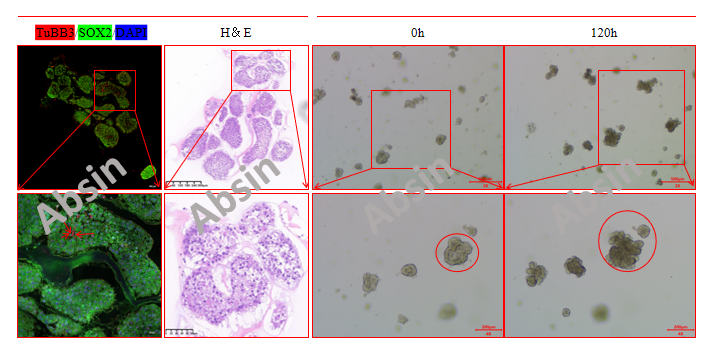
|
Catalog Number |
Product Name |
Specification |
|
Human Gastric Cancer Organoid Culture Medium Kit |
1kit |
|
|
GFR OrganoGel Phenol red free |
1.5ml*8 |
Absin provides antibodies, proteins, ELISA kits, cell culture, detection kits, and other research reagents. If you have any product needs, please contact us.
|
Absin Bioscience Inc. |
 Follow us on Facebook: Absin Bio Follow us on Facebook: Absin Bio |
April 29, 2025
Clicks:117
